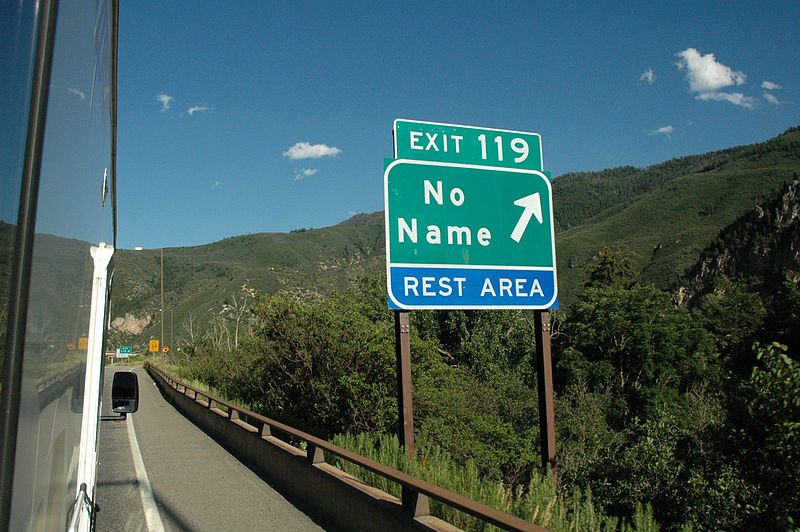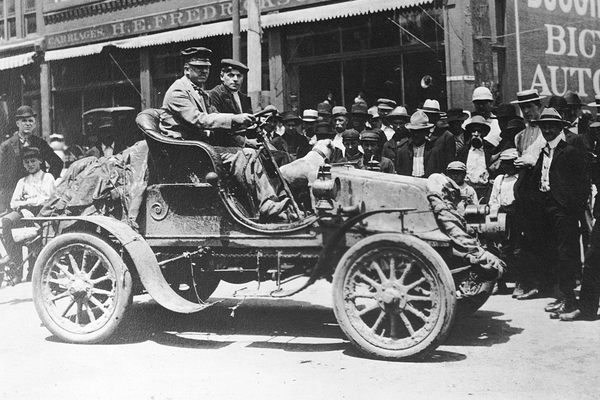Where Do the Streets Have No Name? Everywhere, in America
A road by any other name.
Yazoo City, Mississippi’s No Name Road lives up to the name—a dead-end dirt road in the middle of farmland, it looks about as desolate as the name implies. Hackensack, Minnesota’s Noname Avenue is located near the edge of Birch Lake, with not much on it other than a few trees and a couple of houses.In Longmont, Colorado, there’s a “No Name Blvd.” that’s so hard to discover that it doesn’t even show up in Google Maps or in the phone book—it was only introduced to the internet thanks to the hard work of a guy who spent 2013 literally trying to walk down every street in Longmont. Connecticut, meanwhile, has at least three.
Perhaps the most impressive monument on a No Name road is on the corner of Giant City Road and East No Name Road on the outskirts of Carbonale, Illinois. There lies a Dungeon & Dragons–themed memorial park, built in honor of a 19-year-old fan who died in a car accident.
These are but a few of the streets, boulevards, avenues and roads in America that are purposely named the name “No Name”. But why? At first blush, it seems to be a persistent cartographer joke, a quiet irony that flies by the rear-view during a road trip. But a deeper dive reveals the diffuse naming practices of our roads—it’s not cartographers so much as town leaders (a group that spans from local government members to emergency responders) that are responsible for the no-name names.
People love other things without names, too—and plenty of those have left marks on the map. Towns with no names, for example, are pretty uncommon. But yes, at least one exists. If you travel down Interstate 170 through Garfield County, Colorado, you’re bound to eventually run into Exit 119, where you’ll run into the town of No Name—where you can grab a bite to eat at the No Name Bar & Grill and get some design work done by No Name Architects.
Located off of I-70, Colorado Department of Transportation officials decided that there needed to be an exit at mile marker 119. Unfortunately, they didn’t have a name at the ready, so a placeholder was created. Eventually, the “name” went up the chain of command and stuck, with “No Name” getting printed on exit signs. By then, the residents of what eventually became a resort town came to actually like “No Name” as a name, and here were are, talking about it here.
Also called “No Name”? One of the Florida Keys. In recent years, No Name Key has gained a bit of notoriety because residents were banned by law from hooking up to the electrical grid, leading to an unusual legal fight that was something of a proxy battle over the character of the Florida Keys. No Name was one of the few islands that hadn’t been covered by bars, strip malls, and other touristy stuff.
In the end, though, No Name Key got its electricity, but it still doesn’t have a name.
Going back to the roads, the obvious question here: How did these roads officially come to be called “No Name,” to the point where signs were printed up and the official result shows up in a GPS.

Unlike the interstate highway system, there isn’t a set of rules at play—and that’s what leads to these aberrations. Roads tend to be one of those things where the names come without any set-aside rhyme or reason. Outside of the highways and byways, road-naming generally falls to the local community, each of whom has their own approach.
That approach tends to be more formalized within cities than outside of them.
In Carbondale, Illinois, for example, the city chooses its street names based on decisions by the city council, but it doesn’t have any jurisdiction outside of the city boundaries, where the Dungeons & Dragons park is located. So as a result, the job falls to Jackson County. Who makes the call in Jackson County? After a bit of checking, I found out that the the 911 responders do.
That sounds odd, but it kind of makes sense, if you think about it. Emergency responders need to have an understanding of the lay of the land, and 911 responders have an important role in keeping those addresses memorized and mapped out—as well as ensuring that the names aren’t confusing.
Melinda Woker, the director Jackson County’s 911 service, offers a pretty good example of this point in action—she started out with the department in 2002 as a geographic information system (GIS) expert, working her way up the ranks. Woker (who admits that “no one has ever asked a question quite like this” when I reached out to her) says that the job fell to the responders in the early 1993, when the department was first established. Before then, local residents made up names for roads.

“In general, residents were asked to give input on naming the road on which they lived; in many instances, there were colloquial names for roads that were turned into ‘official’ road names,” Woker explains. And this was how Carbondale’s No Name Road gained its name: Local residents chose to call it “No Name Rd,” and the county kept it around. And the department said that the name, which sounds confusing in theory, isn’t actually confusing in practice.
“So technically, ‘No Name Rd’ is named, albeit ironically, and is in the public record and in the county plat map,” Woker adds.
Meanwhile in Arizona, a “No Name Rd” near Tombstone is located in High Knoll Ranches, a private community outside of Sierra Vista. In that town, the names are chosen based on the desires of private developers, but are approved by the city’s community development department.
“This step ensures that we don’t end up with duplicate or offensive names,” explains Judy Hector, the city’s marketing and public affairs manager.

That government-oversight step, for example, ensures that every street in Sierra Vista doesn’t have the word “calle,” the Spanish word for “street,” in front of it. Occasionally, the city council will get involved there as well if, say, the street is a major street. But with the road just outside of city limits, the naming rights for this road fell to Cochise County, which—believe it or not—actually received a petition from local residents to change the name of the road to “No Name Road” in 1993. The county’s planning and zoning commission complied.
Ted Forte, the head of the High Knoll Ranches Road Improvement and Maintenance District, says that early plat maps of the immediate area show that while all the roads around the neighborhood had names, some of those names changing over the years, No Name Road had no listed name. These days, much like the street in Carbondale, it’s now officially called “No Name Road.”
The connecting threads of these roads, in many ways, go beyond the unusually non-descriptive names. In particular, they highlight the ways that local governments handle their affairs—what works best for them and their communities, and the importance of listening to residents instead of making decisions without hearing their neighbors out.
And if their neighbors want a No Name Road, that’s what they’ll get.
This story originally ran in 2016; it has been updated for 2023.











Follow us on Twitter to get the latest on the world's hidden wonders.
Like us on Facebook to get the latest on the world's hidden wonders.
Follow us on Twitter Like us on Facebook